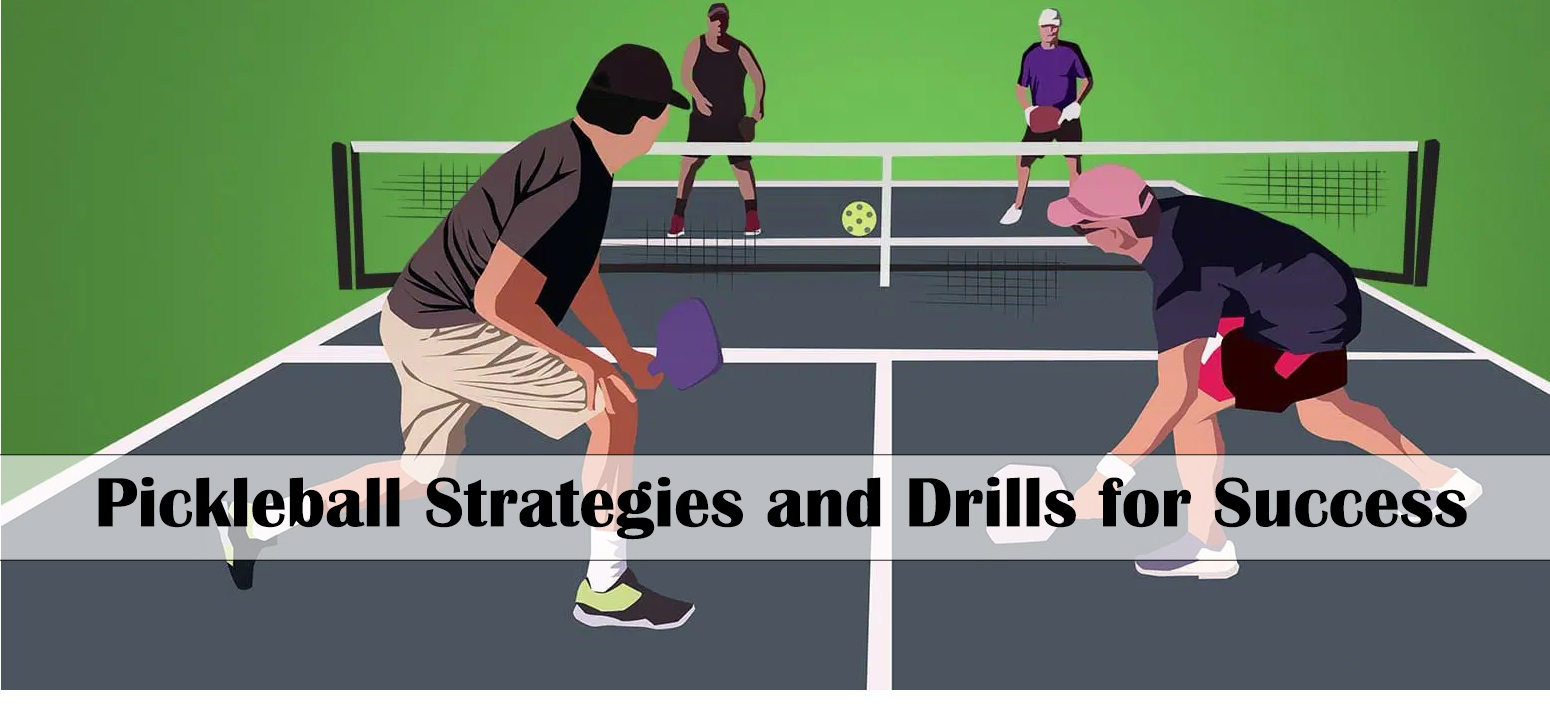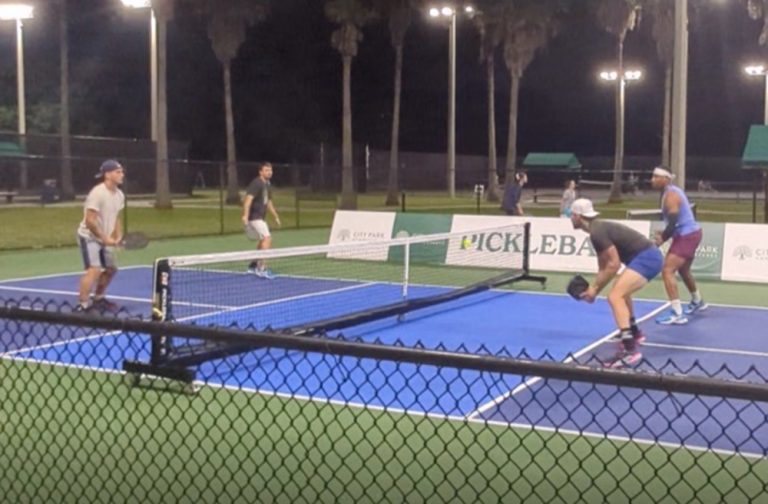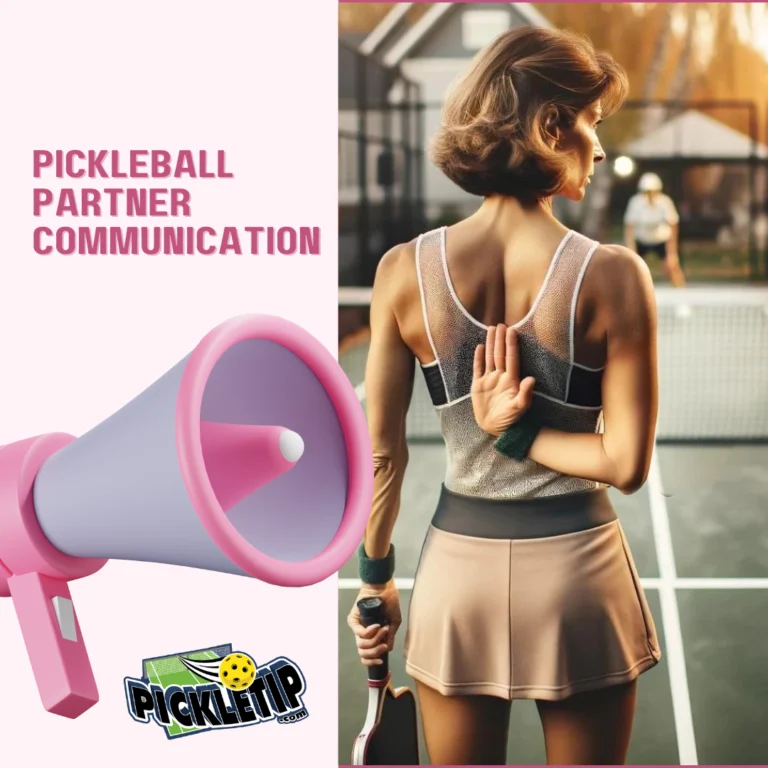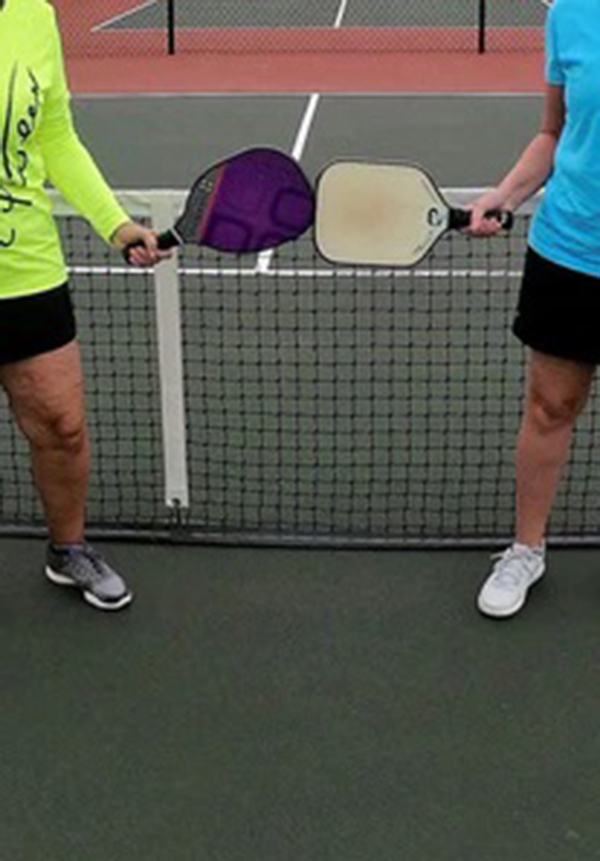Pickleball Strategies and Drills for Success
Strategies and Drills: Understanding the Three Height Zones in Pickleball
In this guide on Strategies and Drills, we’ll delve into the nuances of pickleball, from understanding height zones to mastering advanced moves.
Identifying the height from which players receive the ball can be categorized into three main zones:
- Red Zone (Defensive): Below the knees
- Yellow Zone (Neutral): Knees to waist
- Green Zone (Offensive): Above the waist
Players should aim to attack balls in the Green Zone and play defensively when balls are in the Red Zone. The Yellow Zone requires a strategic approach, depending on the situation.
Key Factors for Attacking the Ball
Before deciding to attack, consider the following:
- Balance: Maintain a stable center of gravity.
- Position: Ensure both partners are in a favorable position to handle counterattacks.
- Strike Zone: Aim for balls in the offensive zone for maximum effectiveness.
The Court’s Transition Area
One of the most misunderstood and underutilized areas in pickleball is the transition area, the space between the baseline and the kitchen line. Historically dubbed “No Man’s Land”, this zone is now being recognized for its strategic potential. Incorporating the right Strategies and Drills can help players maximize the potential of the transition area.
Land of Opportunity vs. No Man’s Land
The term “No Man’s Land” was traditionally used to describe the court section between the baseline and the kitchen line, often viewed as a vulnerable position. However, with evolving strategies and a deeper understanding of the game, many players now see this area as the “Land of Opportunity” or simply the “Transition” zone.
Strategic Advantages of the Transition Area
With the right Strategies and Drills, players can effectively utilize the Transition zone to their advantage.
Here are instances when being in the Transition zone can be advantageous:
- Advancing to the Kitchen: After executing your 3rd shot drop or drive, you might not always have the luxury of time to reach the kitchen line immediately. It’s common to take a few steps forward, execute a split step, hit the 5th shot, advance a bit more, play the 7th shot, and continue this pattern until you’re at the kitchen.
- Defensive Positioning: If you’re at the kitchen and anticipate an aggressive shot from your opponents, stepping back into the Transition zone can be a smart move. This positioning gives you more time to block and defend against powerful strikes. The subsequent challenge is to strategically return to the kitchen line using a combination of drops, blocks, and other shots.
Embracing the Transition
Since starting to play pickleball, I’ve grown more comfortable and confident when positioned in the Transition area. It’s a space that offers both defensive and offensive opportunities, and mastering play in this zone can be a game-changer. One effective drill to practice shots in the Transition area involves a partner feeding balls from the kitchen. Start at the baseline and work your way up to the kitchen with drop shots, then reverse the process. Switch roles and challenge each other to move fluidly between the baseline and the kitchen, mimicking the “slinky” motion of advancing and retreating.
By redefining the Transition area as a “Land of Opportunity”, players can unlock new strategies and elevate their pickleball game. Strategies and Drills focused on the Transition area can be a game-changer.
Focus: Macro vs. Micro
In pickleball, maintaining the right focus is crucial for success. Players need to strike a balance between the broader game situation (macro) and the immediate ball play (micro). By understanding and leveraging these two perspectives, players can gain a strategic edge over their opponents. Effective Strategies and Drills can help players maintain the right balance between macro and micro focus.
Big Picture vs. Small Picture
The “big picture” or macro view encompasses the overall dynamics of the point. It involves understanding:
- Where your opponents are positioned on the court.
- How they are holding their paddles, indicating potential shots.
- What your partner is doing and how you can complement their play.
On the other hand, the “small picture” or micro view is about the immediate moment. It’s the hyper-focus you apply when a ball is rapidly approaching, and you need to decide on the best shot to execute.
It’s essential to prioritize the small picture when you’re about to hit the ball. Your opponents will likely be doing the same, concentrating intensely on their immediate play. Recognizing this, savvy players can employ strategies to divert their opponents’ attention from the small picture, creating opportunities for advantageous plays.
Strategies to Distract Opponents
Incorporating these Strategies and Drills can enhance gameplay and give players a competitive edge.
Several tactics can be used to shift your opponent’s focus from the small picture:
- Ernie Preparation: Move around the kitchen, signaling a potential Ernie, which can divert your opponent’s attention.
- Positional Switch: Switch places with your partner at strategic moments, causing opponents to recalibrate their game plan.
- Poaching: When you’re at the kitchen and your partner is at the baseline or in the transition area, intercept or “poach” a shot. This unexpected move can catch opponents off guard.
While these are common tactics, the key is creativity. The more unpredictable you are, the harder it is for opponents to maintain their micro focus. However, always ensure you’re positioned and ready for the ball, allowing you to concentrate on the small picture when it’s your turn to play.
By mastering the balance between macro and micro focus, players can enhance their gameplay, making them formidable opponents on the pickleball court.
Understanding Court Dynamics in Pickleball
By understanding these Strategies and Drills, players can optimize their roles and maximize their chances of winning points.
The Returning Team’s Advantage
The returning team has several inherent advantages in pickleball:
- Initial Positioning: They start closer to the net, allowing for a more aggressive stance.
- First to Attack: Their position lets them hit an aggressive shot first, putting the serving team on the defensive.
- Pressure on the Server: By hitting deep returns, they can challenge the serving team and make it hard for them to approach the net.
The Serving Team’s Unique Opportunity
The serving team, while facing initial challenges, has unique opportunities:
- Scoring Opportunity: They are the only ones who can score points during their serve.
- Third Shot Strategy: Their third shot is crucial. A well-executed third shot can neutralize the returning team’s advantage.
- Double Serving Advantage: In doubles, both players get a chance to serve, offering multiple scoring opportunities.
Strategic Adjustments Based on Team Roles
Both teams need to adjust their strategies based on their roles:
- For the Serving Team: They should focus on deep serves, prioritize the third shot, and communicate effectively with their partner.
- For the Returning Team: They should aim for deep returns, anticipate the third shot, and maintain net dominance.
Relevant Statistics
Although the returning team is 60-65% likely to win the point. The serving team actually has the advantage because they are the only ones who can win an actual point. These statistics highlight the importance of effective Strategies and Drills in pickleball.
Enhancing Dinking Skills
By focusing on these Strategies and Drills, players can master the art of dinking.
Dinking, or softly hitting the ball just over the net, is a crucial skill. Tips for effective dinking include:
- Engaging the shoulder more than the wrist.
- Maintaining a stable stance.
- Observing opponents’ positions and comfort levels.
Anticipating Out Balls
In pickleball, the ability to anticipate potential out balls before they are struck can be a game-changer. Recognizing these shots early allows players to adjust their positioning and strategy, giving them a significant edge over their opponents. Key indicators like pronounced backswings or off-balance movements from adversaries can often hint at an impending out ball. Effective Strategies and Drills can enhance a player’s ability to anticipate out balls.
Ways to See Out Balls Before they are Hit
While experience and intuition play a role in reading the game, there are specific signs and scenarios that can help players predict out balls. Here’s how you can enhance your anticipatory skills:
- Movement While Driving: If you notice your opponent moving forward while driving the ball, instead of having their feet firmly planted, there’s a higher chance the ball might go out. The forward momentum can often lead to overpowered shots that miss the mark.
- Exaggerated Backswing: An opponent taking a large backswing, especially from the kitchen, can be a telltale sign. Such swings often result in shots with excessive force, increasing the likelihood of the ball going out.
- Off-Balance Swings: Players who are off-balance and still opt for a powerful swing can often misjudge their shots. The lack of stability can affect the angle and force of the hit, leading to potential out balls.
While these scenarios provide a general framework, it’s essential to remember that they are not foolproof. Players develop their unique styles and techniques, and what might be an out ball sign for one might not be the same for another. However, these guidelines serve as a useful starting point and, with experience, players can refine their ability to anticipate out balls more accurately.
By honing this skill, players can position themselves better, conserve energy, and strategize more effectively, ensuring they are always one step ahead of their opponents on the court.
Volley Varieties
In the dynamic game of pickleball, mastering the art of volleying is essential. Different situations call for different types of volleys, and understanding when and how to use each can significantly enhance gameplay and strategy. By understanding these volley Strategies and Drills, players can significantly enhance their gameplay.
3 Types of Volleys in Pickleball
There are three primary volleys that players should be familiar with:
- Push Volley: This volley involves pushing the ball out in front of the body, making contact approximately a foot away. It’s crucial not to overreach. The push volley is best suited for attacking balls around the stomach or chest area and can be an effective counter to an aggressive dink.
- Block Volley: A defensive move, the block volley is used to counter hard-hit balls. The primary objective is to drop the ball into the kitchen, neutralizing the opponent’s attack. For this shot, it’s generally advisable to keep the paddle close to the body, bracing for impact.
- Roll Volley: Often a favorite among former ping pong players, the roll volley is an aggressive shot executed with topspin. It’s typically used against poorly hit drop shots that hover around net level. The topspin ensures that opponents are pushed further back, closer to the baseline.
General Tips for Effective Volleying
While each volley type has its nuances, some overarching principles can guide players towards better volleying:
- Arm Positioning: Imagine having a ball tucked beneath the armpit of your hitting arm. This visualization can aid in achieving better shot accuracy.
- Focus: Concentrate on the “small picture” when executing volleys, paying close attention to the immediate ball play.
- Efficiency: Sometimes, less is more. Utilize the pace of the opponent’s ball to your advantage, redirecting it without exerting unnecessary force.
- Stability: Keep the upper body calm and movements minimal. A stable upper body can lead to more controlled and precise volleys.
It’s essential to remember that while these guidelines provide a foundation, pickleball is a game of variables. Factors like the opponent’s position, ball spin, and court conditions can influence shot selection. However, with practice and a clear understanding of volley varieties, players can navigate these variables with confidence and skill.
Developing a Winning Mindset
In the competitive world of pickleball, technical skills and physical prowess are essential. However, the mental aspect of the game often determines the difference between victory and defeat. Cultivating a winning mindset, characterized by flexibility and resilience, can significantly enhance performance and enjoyment on the court. Incorporating these Strategies and Drills into one’s mindset can lead to better performance on the court.
Tips on Having a Better Pickleball Mindset
Whether you’re a beginner or an advanced player, adopting the right mindset can elevate your game. Here are some insights that can benefit players across all skill levels:
- Perfection Isn’t Always Necessary: While executing the perfect shot is satisfying, it’s essential to remember that sometimes, merely getting the ball over the net can lead to points. Opponents, even at the professional level, can make mistakes. So, focus on consistency and making the opponent play one more shot.
- Adaptability is Key: If your current strategy isn’t yielding results, don’t hesitate to change it up. A flexible approach allows you to explore different tactics and keeps opponents guessing. Especially when trailing, experimenting with new strategies can disrupt the opponent’s rhythm and potentially shift the momentum in your favor.
- Embrace the Game’s Ebb and Flow: Pickleball, like many sports, is a game of momentum. Points can swing dramatically in either direction. Recognizing this, it’s crucial to stay composed during challenging stretches. By focusing on high-percentage shots and trying new strategies, you can potentially reverse a downward spiral and regain control.
- Avoid Rushing, Especially on Serves: Many service faults arise from rushing, often stemming from frustration over a previous point. Taking a moment to reset, breathe, and focus can lead to more consistent and effective serves.
In conclusion, while technical skills are vital in pickleball, a strong mental game can be the X-factor. By adopting a flexible, resilient, and patient mindset, players can navigate the challenges of the game and consistently perform at their best.
Power Serving Tips
These Strategies and Drills for power serving can transform a player’s game.
In my early days of playing, I was a staunch believer in the philosophy that a “safe serve is better than a risky power serve.” It was a conservative approach, rooted in the fear of making unforced errors and giving away easy points. However, as I delved deeper into the game and observed the dynamics, my mindset underwent a significant transformation.
The reality of the sport is that the returning team often holds a distinct advantage to win the point. This advantage stems from the fact that they are in a position to anticipate, react, and strategically place their return, putting the server on the defensive. Recognizing this, I began to reevaluate my serving strategy.
I realized that by merely ensuring my serve went in, I was inadvertently handing the advantage to my opponents. It became clear that if I wanted to level the playing field, I needed to develop a serve that was not just about getting the ball in play but about making it challenging for the returner.
Working on my power serve became a priority. The objective was not just to increase the speed but to:
- Master the art of placement
- Introduce varying spins to the serve
- Deceive the opponent with unpredictable serves
- Adopt a closed stance for more torque
- Hit with topspin for added depth
- Utilize wrist action for enhanced spin
A powerful serve, when executed correctly, can put the returner under immense pressure, leading to a plethora of errors on their part. It’s not just about the sheer pace of the serve but the unpredictability it brings.
Effective Return Strategies
Optimizing return shots is pivotal in setting the tone for the point. Against aggressive hitters, consider loftier returns to neutralize their power. Moreover, it’s crucial to focus on reaching the kitchen line as swiftly as possible after making your return. This positioning can significantly influence the flow of the game.
Pro Tips for Returning Serves
Returning serves is an art, and there are multiple strategies to consider. It’s essential to view the following tips not as definitive rules but as tools in your arsenal. Experiment with them and find what works best for you and your gameplay:
- Time Management: Aim for a return that provides ample time for you to advance to the kitchen. The primary advantage for the returning team is the ability to establish a presence at the kitchen line while keeping the serving team pinned at the baseline.
- Lofty Returns: If you notice that you’re not reaching the kitchen in time for the opponent’s third shot, consider adding more loft to your return. This tactic can buy you those precious extra seconds.
- Backspin Caution: While backspin can be an effective tool, it can backfire when up against powerful hitters, especially if your return falls short. In such scenarios, the spin can make it easier for them to attack.
- Counter Hard Hitters: When facing opponents who frequently drive their third shot, a return with less spin and more height can be more effective. This strategy can neutralize their aggressive playstyle.
- Open Stance for Non-Returners: For the player not returning the serve, adopting an open stance is beneficial. This position allows for better judgment on out calls and provides an opportunity to poach on short returns.
Mastering the art of the return can significantly enhance your game, providing you with strategic advantages and keeping your opponents on their toes.
Advanced Moves: Ernies and Berts
Ernies and Berts are sophisticated techniques that involve striking the ball from outside the court boundaries. While these moves pose a challenge, mastering them can introduce a dynamic twist to your gameplay, catching opponents off-guard.
Berts and Ernies
An Ernie is executed by hitting the ball from outside the court, specifically near the net and to the side of the kitchen. To perform an Ernie during a rally, players can:
- Step through the kitchen with one or both feet.
- Step over the kitchen.
- Jump over the kitchen while striking the ball.
It’s essential to remember that the kitchen is a 2-dimensional space, not 3D. Thus, players can “enter” the kitchen vertically, but they cannot strike the ball while airborne inside the kitchen or land inside due to momentum. However, players can stand beside the kitchen and hit the ball, a move termed as an Ernie, named after a recreational player.
Key considerations while executing an Ernie include:
- Ensuring contact with the ball on your side of the net.
- Following through onto the opponent’s side without touching the net.
- Avoiding any contact with the net, as it results in losing the point.
- Establishing both feet outside the kitchen before hitting the ball. If using the “walk through the kitchen” method, both feet must be outside and on the court surface before the strike.
To effectively set up an Ernie:
- Move the opposing player across from you to the court’s inside with a dink, then to the outside with another dink.
- When the opponent is focused on the immediate play, swiftly move outside the court and prepare for the Ernie.
- Your partner can also assist in setting up an Ernie with cross-court dinks. The key is to wait for the right moment when the opponent is reaching for an out-wide ball, then move for the Ernie.
Note: When attempting an Ernie, it’s crucial for your partner to cover the court’s middle.
Bert vs. Ernie
A Bert is essentially when your partner performs an Ernie in front of you. For instance, if you’re engaged in a dinking rally with the opponent across, your partner might leap over or through the kitchen to intercept and hit the ball mid-air. While Berts are rarer than Ernies, they offer an exciting twist to the game. Mastering an Ernie itself is a challenge, and attempting a Bert, especially when considering the spatial constraints with a partner, is even more daunting.
The Benefits of Drilling vs. Playing
When it comes to improving your pickleball game, both drilling and playing have their merits. However, the advantages of drilling often outweigh casual play, especially when preparing for competitive matches or tournaments.
Maximized Practice Time
Consider this: one hour of dedicated drilling can equate to the benefits of three hours of playing. This means that if you’re gearing up for a tournament or looking to refine specific skills, drilling with your partner can be a more efficient use of your time. Instead of waiting for the right opportunity to practice a particular shot in a game, drilling allows you to repeatedly work on that shot, honing your technique and consistency.
Focused Skill Development
Playing pick-up games is undoubtedly fun and offers valuable real-game experience. However, the unpredictable nature of such games means you might not get to practice the exact skills you want to improve. Drilling, on the other hand, provides a controlled environment where you can focus on specific aspects of your game, be it serving, volleying, or dinking.
Accelerated Growth
Regular drilling sessions can fast-track your skill development. The repetitive nature of drills ensures that you internalize the correct techniques, leading to muscle memory. Over time, this can translate to more accurate and consistent shots during actual games.
While there’s no substitute for the experience gained from actual gameplay, it’s essential to recognize the unparalleled value of drilling. Whether you’re a novice aiming to grasp the basics or a seasoned player looking to perfect your game, integrating focused drilling sessions into your training routine can significantly elevate your pickleball prowess.
Strategies and Drills
Mastering pickleball requires a combination of strategy, skill, and mindset. By understanding and implementing the concepts discussed, players can elevate their game and enjoy greater success on the court. Strategies and Drills should be focused on when attempting to improve your game.








4 Comments